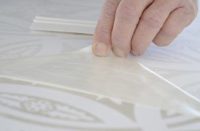
A Concretizen employee discusses the details of a job with the homeowner. Decorative concrete contractors offer different services, use different tools and brands and prefer different application techniques. But if a common thread runs between them beyond their interest in decorative concrete, it is the knowledge that customers keep their businesses going. The bottom line is, good customer service can make or break a company.
Old-fashioned values
Ira Goldberg, of Beyond Concrete in Keyport, N.J., has owned a concrete business for 23 years and been in the trade for 31 years. In that time, he has stayed with the same customer-service strategies: “The customer is always right” and “the customer comes first.” Another critical aspect of his company’s success, Goldberg says, is always returning any customer’s call within 24 hours. “People especially like the fast response. Some are even surprised that we call back that fast — especially if it is a complaint, which doesn’t happen that often.”
Dana Boyer, owner of Concretizen, located in Apache Junction, Ariz. also has a simple style of customer service that has worked for her since she started her company. “My approach to customer service is still the same. I treat the customers the way I would want to be treated. I give them a product that I would personally be happy paying for. I give them educated options and let them make an informed decision. Customer service is everything to my company. Without customer service I wouldn’t be in business. Our mantra is, ‘We are what others are not.’ I fully believe that and will go the extra mile to know they are happy.”

Part of the team
One good way to ensure good customer service is to make sure that customers get what they want. “Our No. 1 customer service strategy is simple communication, from scheduling, to progress reports, to digital images sent to customers to show updates or completed work,” says Chris Becker, owner of Becker Architectural Concrete in South St. Paul, Minn. “We want our clients to feel as though they are our only customer.”
Becker says the company’s 4,000-square-foot showroom is a great customer-service tool that displays the company’s talent and inspires customers’ own ideas throughout the design process.
Gerald Taylor, owner of Images in Concrete, in El Dorado, Ark. also emphasizes client communication and involvement. “At Images In Concrete, Steven Ochs and I allow the client to be part of the design team,” he says. “We feel that is crucial in the progression of the job. We take their ideas and create scale drawings. They cross out what they don’t like. We do this to a point until it’s pleasing to them and practical for us to do. Then we have them sign off. When we finish the work they call it theirs because we really worked with their ideas.”
Customer involvement is also an important aspect at Concretizen. “My customer has a lot to do with the decision process,” Boyer says. “I try to get to know them, see how they are going to use the floor, and realistically, maintain the floor. I talk to them about what they expect from the finished products and have them visually show me objects that they can relate to in regards to color and textures. From there I dial in the project and on the final day before sealing, I have them be present and I fine-tune things to their liking. We definitely are a ‘custom’ company.”
Communicating the customer’s role in the final product is also important for Lee Levig, owner of Concrete Works in Fairfield, Calif. “It is always an evolution.” Levig says that his preparation for a job has changed since he started in the business. “I think customers need to know what to expect. Don’t oversell the job — I think that is the key.” This includes preparing the customer for concrete maintenance and letting them know that the job is done by hand and that there are always imperfections, Levig says.
Delegating roles
Starting out with three employees and increasing to 15 over the years has helped Becker take a more specific approach when it comes to customer service. “We have defined roles that are in addition to my employees’ everyday responsibilities. One takes care of warranty and service work, one takes care of scheduling and updates — something we do with every active customer every Monday morning. We have a person dedicated to servicing our retail clients, like IKEA, for whom we fabricate concrete countertops, so there is one person that information flows to for almost every aspect of our customers’ experience.” However, Becker says that all his employees participate in ongoing weekly meetings to discuss customer feedback from surveys, on-site discussions and focus group meetings.
After the work is done
Once a company finishes a job however, their customer service is not done. “We work on cleaning up after ourselves,” Taylor says. “This speaks volumes in itself when some contractors in other crafts leave such a mess.”
In the longer term, there are many ways a company can leave a good impression. By educating its customers, a business can save both the customers and the company itself from a nightmare. “The big thing I see in decorative concrete today is that a lot of my competitors don’t disclose the maintenance level for concrete,” says Levig, whose son just started a side business to maintain concrete because a lot of customers don’t know how. Levig’s business practice is to educate customers up front so they know what to expect — what is normal wear and tear and what would be covered under warranty.
Levig says you need to know how to identify when to go back and fix something and when to say no. If a customer has a crack in the entrance of their business and they are irritated about it, you may not be required to go back and fix the crack, but you should, Levig says. “There is a fine line between customer service and customer warranty and as a business you need to decide when to cross that line.”
Providing good follow-up after the job is done can only help your business. “Yesterday I picked up and delivered a gallon of wax and neutral cleaner to a very nice family,” Taylor says. “I did a job for them that was featured on the cover of Concrete Decor way back in 2003. That could be considered customer service after the job. They always go out of their way to let the guests they entertain know who did their floor.”
And leaving a good impression on a customer will most certainly pay off. “One bad job sure gets known 10 times faster than one good job,” Goldberg says.















